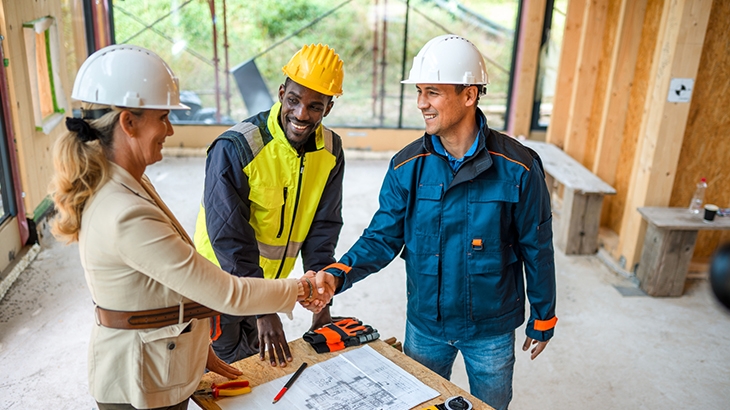How to Build a Custom Home from Foundation Framing to Exterior Finishing
You've finally found that perfect lot to build your dream home. You've budgeted, drafted, and gotten the financing and plans to make something happen. Now, the real work begins! A custom build involves a lot of moving pieces, but here are the basic steps in building your new home.

Choose Your Professionals
While you'll usually only have one general contractor or custom home builder, building a home is a massive project that requires multiple subcontractors. Your builder will oversee construction on your home from start to finish, get estimates for labor and materials, vet and hire subcontractors, assign tasks, and ensure everyone meets their deadlines. The professionals you work with might include architects and interior designers, and you'll definitely work with plumbers, electricians, and others who will contribute to building your home. Choosing the right person is critical—they should understand your vision and have the skills and credentials to bring your dream to life. Your lender should have a list of preferred builders. If they've made it to the list, they've been vetted by your lender and should have proven themselves to be a good company to work with. That said, think about asking for photos of previous projects to see if they have experience with the home you want to build.
Permits
Permits will be a big part of the process, and inspections will usually accompany any permits you apply for. Thankfully, your builder will know what permits are necessary and may have an established relationship with the city or county the permits are submitted to, which can help speed up the process. There are different permits for building, electrical, plumbing, and HVAC, among others. Only begin construction after obtaining permits, as you could face fines to get the proper permits or be required to shut down construction entirely until permits are obtained. In some cases, you may have to tear down work completed before the proper permits were granted.
Readying the Lot to Lay the Foundation
Out with the old, in with the new. If there are existing structures on your lot, you may need a separate demolition permit and public notice of the proposed work to be completed. Once any existing structures are cleared, excavation or the readying of the land can begin to lay the foundation for the new home. If there is an existing foundation, it might be able to be used for the new house, depending on its condition. Once that's complete, an inspection is done by the city or county and the title insurance company if financing is involved. The inspection applies to all foundations regardless of who performs the foundation work. Any subsequent work can only proceed once the inspection is complete since the foundation will be covered up, making inspection difficult.
Framing, Subfloor, Doors, and Windows
After the foundation has passed inspection, framing can begin. Once that's done, the city or county does another inspection, and again, any subsequent work can only proceed once it passes inspection. Once the frame or shell of the house is up, sheathing made of wood or other materials are attached to the framework to give the structure more strength. It will also be wrapped with a synthetic material, which functions as a barrier to prevent rain from entering the wall assembly while allowing water vapor to pass to the exterior. If moisture from either direction is allowed to build up within stud or cavity walls, mold and rot can set in, which makes wrapping a critical step. Interior subflooring is then installed; this allows contractors access to the interior of the home and is ready for future installation of finished flooring. There is a lot still to be done, so finished flooring will not be installed until after most other work is completed to keep it from getting damaged and going through unnecessary wear and tear. Sometime during the process, windows and doors will be installed as well.
Roofing
The construction of the roof follows the framing of the home. The underlying support and pitch of the roof will depend on the type of roofing materials used. The pitch is the angle at which the roof rises from its lowest to its highest point. Some roofing materials (stone, concrete, etc.) require more structural support than composition or cedar shake roofing material. The pitch and type of material partly depend on style, cost, and practical considerations, like the usual amount of rain or snowfall seen in a year. Roofing materials are applied on top of the vapor barrier or underlayment and framework of the roof.
Plumbing, HVAC, and Electrical Installation
After framing, but before the drywall is installed, there will be a rough-in stage of installation when access is still available to the space between the studs, floor joists, and ceiling joists. Rough plumbing involves the installation of water and sewer pipes, vents, and bathtubs throughout the shell of the home. Your plumber will set up pipes to facilitate the connections for toilets, faucets, drains, and other necessities, which will be installed in the later stages of construction. Electrical installation involves wiring, boxes, fixture mounts, breaker panels, and sub-panels. Light switches, outlets, and other fixtures will come during the final phase as construction work nears completion. Generally, after the electrical is done, it's time to install the HVAC (heating, ventilation, and air conditioning) system. HVAC could involve simple baseboard electric heating or a more complex heating system of oil, gas, or passive heating. An electrical and possibly a plumbing inspection is done by the city or county before covering the work with drywall.
Insulation and Drywall
Next, the home's interior is insulated, which is used to cover, line, or separate parts of the house to prevent or reduce the passage, transfer, or leakage of heat, electricity, and sound. After the home is insulated, the drywall is added. Drywall, sometimes known as sheetrock, plasterboard, wallboard, or gypsum board, is used to create interior-facing walls and ceilings. Once that's up, drywall mud hides the joints and covers nail heads. They will also cut out holes for lighting fixtures and outlets during this process. Then, the drywall is primed with sealer so paint can be evenly applied.
Interior and Exterior Finishing
Now, the interior painting and finish work can be completed. This includes building shelving, woodwork, and cabinets and installing new appliances, mirrors, and various fixtures, such as electrical outlets. As the individual rooms are near completion, flooring is also installed. At the same time, exterior siding is applied to the walls of the house, and any deck and landscaping work is completed.
WaFd Bank is Here to Help
When it comes to getting your finances in order for the ups and downs of life, a little planning goes a long way. Whether you're a seasoned budgeting pro or new to saving (check out WaFd Bank's account options while you're here), your local WaFd Bank branch is available to help you reach your financial goals. Open an account online, visit your local branch, or give us a call at 800-324-9375 to learn more and open an account today.
Did you find this article helpful? Share it!


